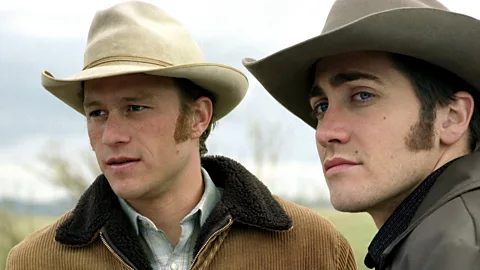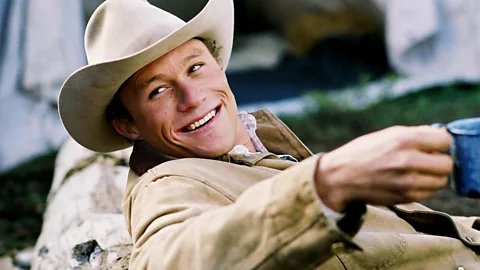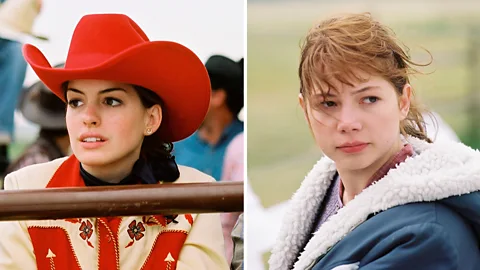 Alamy
AlamyTwenty years ago, Ang Lee’s drama about the love between two male sheep herders was finally released after a long struggle to get it made. It was a watershed moment for gay representation that balanced playing by Hollywood’s rules and changing them.
When it was released in 2005, Brokeback Mountain entered the collective consciousness in a way that is vanishingly rare for a film with queer subject matter. Even non-cinephiles would have been aware of the “gay cowboy movie”, as it was often described in the press, and the subsequent controversy when it lost the Academy Award for best picture to Crash, a clumsy crime film that now regularly appears on lists of the worst Oscar winners ever.
Brokeback Mountain did take home three Oscars, including a prestigious best director prize for Ang Lee, and remains a beloved gay touchstone. Actor Paul Mescal recently complained that it feels “lazy and frustrating” to compare his upcoming film The History of Sound, a period romance in which he and Josh O’Connor play travelling lovers in rural Maine, to Lee’s tender neo-Western about romantically attracted sheep herders Ennis Del Mar (Heath Ledger) and Jack Twist (Jake Gyllenhaal). Whether you agree with Mescal or not, the persistent comparisons are a sign of Brokeback Mountain’s enduring impact and popularity. Indeed, to mark its 20th anniversary, Lee’s film is now being re-released in US cinemas this week for a limited engagement.
 Alamy
AlamyAdapted by screenwriters Larry McMurtry and Diana Ossana from a 1997 short story by Annie Proulx, Brokeback Mountain was a relatively novel proposition back in 2004. “The fact its two leads were handsome A-list male stars and [it showed] their characters in a romantic story together was groundbreaking,” says Tim Teeman, author of In Bed With Gore Vidal: Hustlers, Hollywood, and the Private World of an American Master. This view is broadly echoed by queer film critic Manuel Betancourt, author of Hello Stranger: Musings on Modern Intimacies, who says the film’s success with critics and audiences alike felt like the start of a “new era of gay representation [on screen]”.
At the time, Brokeback Mountain looked like a surprising pivot from director Ang Lee, who had recently made the 2003 superhero film Hulk, though his other directing credits ranged from an acclaimed Jane Austen adaptation (1995’s Sense and Sensibility) to a hugely successful martial arts film (2000’s Crouching Tiger, Hidden Dragon). The film’s core cast was a quartet of hotly-tipped rising stars in their twenties: Ledger and Anne Hathaway would go on to win Oscars for subsequent roles, while Gyllenhaal and Michelle Williams are rarely far from the awards season conversation.
How it was pioneering
“It’s easy to take for granted the way that Brokeback Mountain, with its starry cast and A-list director, profoundly changed the shape of LGBTQ+ representation in the mainstream,” argues Kyle Turner, author of The Queer Film Guide: 100 Films That Tell LGBTIA+ Stories. Turner notes that “the wave of mainstream queer moves in the 90s” tended to “toggle between Aids-related dramas like Philadelphia (1993) and And the Band Played On (1993), and lighter comedies like The Birdcage (1996) and In & Out (1997)”. By contrast, he believes that Brokeback Mountain carved out a new niche as a “straightforward and serious” film that won “newfound respectability” for a romantic story involving same-sex lovers.
That story begins in rural Wyoming in 1963, when drifters Ennis and Jack are hired by a local rancher to herd sheep through grazing ground on the titular Brokeback Mountain. One night, with their inhibitions loosened by moonshine, Jack makes a pass at Ennis and the two men have sex in a tent – a pretty audacious scene for a mainstream film in 2005. When Brokeback Mountain came out in December 2005, Ossana, who was also the film’s producer, made a point of attending screenings in some of the US’s more conservative states to gauge the audience’s reaction. “The theatres were packed, and in every theatre it was the same – after the tent scene, five or six people would get up to leave,” she tells the BBC.
Brokeback Mountain grows sadder and more anguished after Ennis and Jack consummate their relationship. Their sheep-herding summer ends with the two men scrapping, presumably in frustration at the romantic feelings they dare not acknowledge. Ennis then marries his fianceé Alma (Williams), while Jack meets and marries rodeo rider Lureen (Hathaway). It’s four years before the two men meet again, at which point Jack asks Ennis to leave Alma and build a life with him. Heartbreakingly, it’s a giant leap that Ennis can’t bring himself to make. “Everyone talks about the 1960s being a time of ‘free love’, but it was actually a very narrow-minded and restrictive time for many people in America – that’s what the hippies were rebelling against,” Ossana says.
 Alamy
AlamyFor Ennis, the prospect of living in a gay relationship with Jack is simply too much to countenance, so for the next 20 years, their passion is limited to sporadic fishing trips that are separate from their everyday lives. The men are affected by overt external homophobia: when Jack returns to Brokeback Mountain, he is told by a prejudiced rancher that there is no work there for men “who stem the rose”, a deceptively elegant euphemism for gay sex. But ultimately, it is Ennis’ deep-rooted internalised homophobia that thwarts their potential happiness.
The challenges of getting it produced
Thinly-veiled homophobia – this time in early-2000s Hollywood – made Brokeback Mountain an immense challenge for Ossana and her fellow producer James Schamus. After she read Proulx’s short story in 1997, Ossana and screenwriting partner McMurtry persuaded the author to let them adapt it for the screen. “Annie said, ‘I don’t see a film there, but have at it,'” Ossana recalls. They completed the screenplay in three months, but it took nearly eight years to get the film into production. “The biggest problem was casting Ennis. Actors would commit and then back out, or they just were too afraid based upon what their representatives were telling them,” she explains – because for an aspiring leading man at the time, playing a gay character was widely viewed as “career suicide”.
After Lee joined the project in 2001, the producers found an actor willing to play Ennis, but this star dropped out around five months later. “I already had a feeling he might back out,” Ossana says, alluding to the widely held trepidation about playing a gay character. By this point, she was already convinced that Ledger was perfect for the role based on his haunting performance in the 2001 romantic drama Monster’s Ball. Crucially, too, he had previously “played a gay teenager in a soap opera” in his native Australia, so Ossana hoped he might be more “open” than his American peers.
Her hunch was correct, but Ossana says studio executives were initially reluctant to cast Ledger because they felt he wasn’t “macho enough” to play a cowboy – or even a “wannabe cowboy”, as she sees the character. “It was probably helpful, in terms of the film’s infiltration into the mainstream, that [Ennis and Jack] are two men who inhabit a conventional kind of masculinity,” Turner says. Betancourt believes Brokeback Mountain was able to provide a watershed moment in LGBTQ+ representation precisely because it was rooted in proven Hollywood tropes. “As a Western and a melodrama, it played within two well-worn genres and infused them both with new vibrancy – mainly due to the fact it’s a love story between two men,” he says.
 Alamy
AlamyAt the same time, Brokeback Mountain also adheres to another Hollywood trope: what Teeman describes as depicting “queer love as beautiful but doomed”, a narrative that plays out in the likes of The Children’s Hour (1961) and Philadelphia (1993). The two men’s flickering romance is finally extinguished when Jack dies in ambiguous circumstances. Lureen tells Ennis over the phone that Jack was killed by an exploding tyre – though at the same time, we see images of Jack being viciously beaten by a group of men. Ennis is envisioning, all too believably, his lover being killed in a homophobic hate crime.
Its debatable legacy
Perhaps because it played by the rules while challenging them at the same time, Brokeback Mountain’s place in film history is assured. In 2018, it was selected for preservation in the United States National Film Registry, which recognises works that are “culturally, historically, or aesthetically significant”. It occupies an equally integral, though more complicated place, in the queer film pantheon. “As a piece of cinema, it remains as ravishing and disarming as ever,” Betancourt argues, “but as a pivot point for queer representation, it remains as singular but limiting as it was then.” It is, after all, the story of two closeted gay or possibly bisexual men who “pass” as straight in their everyday lives.
Though Brokeback Mountain remains important and influential, it’s difficult to quantify its long-term impact on LGBTQ+ representation. Teeman notes that Hollywood gave a green light to several “mainstream queer-themed films” in its wake, notably Milk (2008) and The Kids Are All Right (2010); these were followed in turn by Carol (2014), Moonlight (2016) and Call Me by Your Name (2017). But he also believes “there’s little consistency and regularity in the flow of queer-themed stories and lead characters to the screen”. For Teeman, “TV and theatre are [still] more radical than film when it comes to queer representation.”
Brokeback Mountain also retains a unique relevance because of its place in the ongoing debate about whether straight actors should play gay roles. Both Gyllenhaal and Ledger, who died in 2008, are widely presumed to be heterosexual, though Ossana says it was “none of my business” as a producer to ask questions about their sexual orientation. “It’s the old chestnut, and Brokeback Mountain is the ultimate exemplar,” Teeman says. But even with these caveats, it remains a stunning and heartbreaking piece of cinema that strikes a particular chord with LGBTQ+ viewers. Brokeback Mountain offers a stark reminder that denying your true identity is a tragedy that can derail several lives at once.
Brokeback Mountain is being re-released in US cinemas, beginning with special showings on June 22 and 25.


